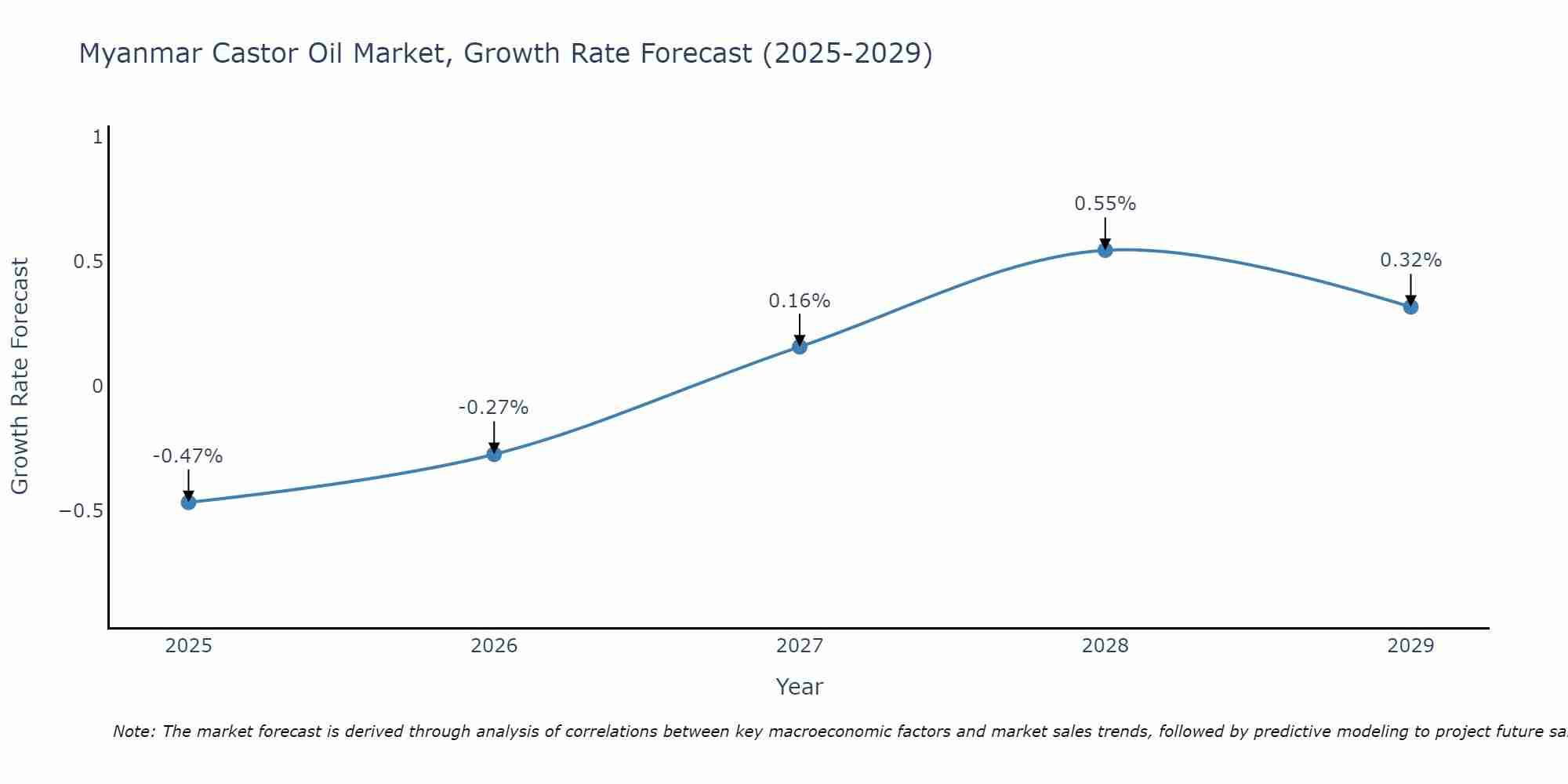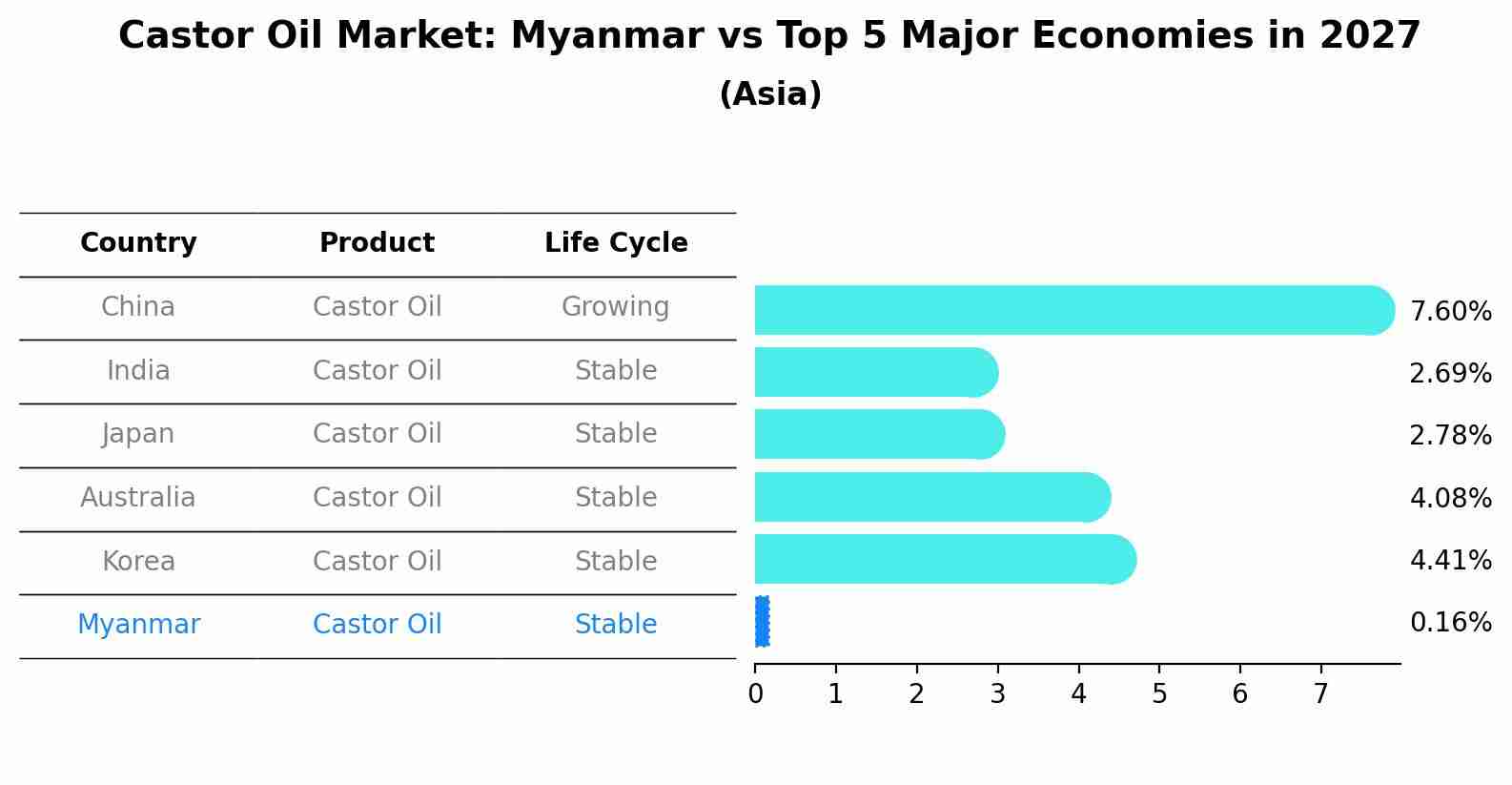Myanmar Castor Oil Market (2025-2031) Outlook | Analysis, Companies, Growth, Value, Industry, Share, Size, Forecast, Revenue, Trends
| Product Code: ETC410070 | Publication Date: Oct 2022 | Updated Date: Apr 2025 | Product Type: Market Research Report | |
| Publisher: 6Wresearch | Author: Shubham Padhi | No. of Pages: 75 | No. of Figures: 35 | No. of Tables: 20 |
Myanmar Castor Oil Market Size Growth Rate
The Myanmar Castor Oil Market is projected to witness mixed growth rate patterns during 2025 to 2029. Growth accelerates to 0.55% in 2028, following an initial rate of -0.47%, before easing to 0.32% at the end of the period.

Castor Oil Market: Myanmar vs Top 5 Major Economies in 2027 (Asia)
By 2027, the Castor Oil market in Myanmar is anticipated to reach a growth rate of 0.16%, as part of an increasingly competitive Asia region, where China remains at the forefront, supported by India, Japan, Australia and South Korea, driving innovations and market adoption across sectors.

Myanmar Castor Oil Market Overview
The castor oil market in Myanmar is developing, with castor oil being valued for its wide range of industrial and pharmaceutical applications. It is used in the production of lubricants, soaps, pharmaceuticals, and cosmetics. The growth of this market is driven by the increasing awareness of castor oil`s benefits and the rising demand for natural and organic products. However, the market`s expansion is limited by the low domestic production of castor seeds and the need for improved processing facilities.
Drivers of the market
The Myanmar Castor Oil Market is driven by the versatile applications of castor oil in various industries, including pharmaceuticals, cosmetics, and lubricants. Castor oil`s anti-inflammatory and antibacterial properties make it a valuable ingredient in the pharmaceutical and cosmetic sectors. The growing preference for bio-based and sustainable products further propels the market. Additionally, castor oil`s use in industrial applications, such as in the production of biofuels and polymers, supports its market growth.
Challenges of the market
Challenges in the castor oil market include inconsistent supply due to weather fluctuations, limited processing capabilities, and the need for sustainable farming practices to meet international quality standards.
Government Policy of the market
In the castor oil market, government policies may aim to support the cultivation of castor beans and the production of castor oil as part of agricultural development strategies. This could include subsidies for farmers, research and extension services, and policies to encourage investment in processing facilities. Additionally, trade policies may impact the import and export of castor oil, with tariffs and trade agreements affecting market dynamics.
Key Highlights of the Report:
- Myanmar Castor Oil Market Outlook
- Market Size of Myanmar Castor Oil Market, 2024
- Forecast of Myanmar Castor Oil Market, 2031
- Historical Data and Forecast of Myanmar Castor Oil Revenues & Volume for the Period 2021-2031
- Myanmar Castor Oil Market Trend Evolution
- Myanmar Castor Oil Market Drivers and Challenges
- Myanmar Castor Oil Price Trends
- Myanmar Castor Oil Porter's Five Forces
- Myanmar Castor Oil Industry Life Cycle
- Historical Data and Forecast of Myanmar Castor Oil Market Revenues & Volume By End Use for the Period 2021-2031
- Historical Data and Forecast of Myanmar Castor Oil Market Revenues & Volume By Pharmaceuticals for the Period 2021-2031
- Historical Data and Forecast of Myanmar Castor Oil Market Revenues & Volume By Lubricants for the Period 2021-2031
- Historical Data and Forecast of Myanmar Castor Oil Market Revenues & Volume By Paints for the Period 2021-2031
- Historical Data and Forecast of Myanmar Castor Oil Market Revenues & Volume By Soaps for the Period 2021-2031
- Historical Data and Forecast of Myanmar Castor Oil Market Revenues & Volume By Others for the Period 2021-2031
- Myanmar Castor Oil Import Export Trade Statistics
- Market Opportunity Assessment By End Use
- Myanmar Castor Oil Top Companies Market Share
- Myanmar Castor Oil Competitive Benchmarking By Technical and Operational Parameters
- Myanmar Castor Oil Company Profiles
- Myanmar Castor Oil Key Strategic Recommendations
Frequently Asked Questions About the Market Study (FAQs):
- Single User License$ 1,995
- Department License$ 2,400
- Site License$ 3,120
- Global License$ 3,795
Search
Thought Leadership and Analyst Meet
Our Clients
Related Reports
- Canada Oil and Gas Market (2026-2032) | Share, Segmentation, Value, Industry, Trends, Forecast, Analysis, Size & Revenue, Growth, Competitive Landscape, Outlook, Companies
- Germany Breakfast Food Market (2026-2032) | Industry, Share, Growth, Size, Companies, Value, Analysis, Revenue, Trends, Forecast & Outlook
- Australia Briquette Market (2025-2031) | Growth, Size, Revenue, Forecast, Analysis, Trends, Value, Share, Industry & Companies
- Vietnam System Integrator Market (2025-2031) | Size, Companies, Analysis, Industry, Value, Forecast, Growth, Trends, Revenue & Share
- ASEAN and Thailand Brain Health Supplements Market (2025-2031) | Strategy, Consumer Insights, Analysis, Investment Trends, Opportunities, Growth, Size, Share, Industry, Revenue, Segments, Value, Segmentation, Supply, Forecast, Restraints, Outlook, Competition, Drivers, Trends, Demand, Pricing Analysis, Competitive, Strategic Insights, Companies, Challenges
- ASEAN Bearings Market (2025-2031) | Strategy, Consumer Insights, Analysis, Investment Trends, Opportunities, Growth, Size, Share, Industry, Revenue, Segments, Value, Segmentation, Supply, Forecast, Restraints, Outlook, Competition, Drivers, Trends, Demand, Pricing Analysis, Competitive, Strategic Insights, Companies, Challenges
- Europe Flooring Market (2025-2031) | Outlook, Share, Industry, Trends, Forecast, Companies, Revenue, Size, Analysis, Growth & Value
- Saudi Arabia Manlift Market (2025-2031) | Outlook, Size, Growth, Trends, Companies, Industry, Revenue, Value, Share, Forecast & Analysis
- Uganda Excavator, Crane, and Wheel Loaders Market (2025-2031) | Strategy, Consumer Insights, Analysis, Investment Trends, Opportunities, Growth, Size, Share, Industry, Revenue, Segments, Value, Segmentation, Supply, Forecast, Restraints, Outlook, Competition, Drivers, Trends, Demand, Pricing Analysis, Competitive, Strategic Insights, Companies, Challenges
- Rwanda Excavator, Crane, and Wheel Loaders Market (2025-2031) | Strategy, Consumer Insights, Analysis, Investment Trends, Opportunities, Growth, Size, Share, Industry, Revenue, Segments, Value, Segmentation, Supply, Forecast, Restraints, Outlook, Competition, Drivers, Trends, Demand, Pricing Analysis, Competitive, Strategic Insights, Companies, Challenges
Industry Events and Analyst Meet
Whitepaper
- Middle East & Africa Commercial Security Market Click here to view more.
- Middle East & Africa Fire Safety Systems & Equipment Market Click here to view more.
- GCC Drone Market Click here to view more.
- Middle East Lighting Fixture Market Click here to view more.
- GCC Physical & Perimeter Security Market Click here to view more.
6WResearch In News
- Doha a strategic location for EV manufacturing hub: IPA Qatar
- Demand for luxury TVs surging in the GCC, says Samsung
- Empowering Growth: The Thriving Journey of Bangladesh’s Cable Industry
- Demand for luxury TVs surging in the GCC, says Samsung
- Video call with a traditional healer? Once unthinkable, it’s now common in South Africa
- Intelligent Buildings To Smooth GCC’s Path To Net Zero


















